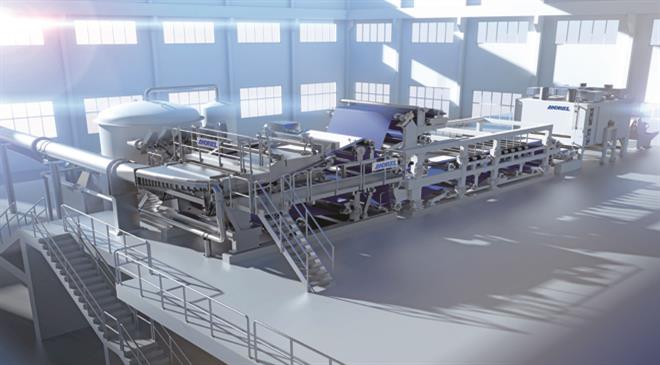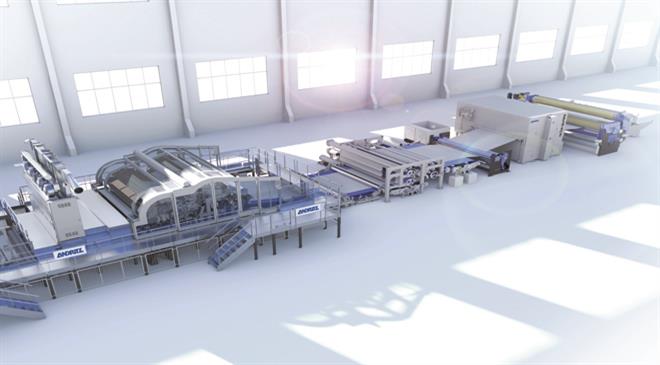TT: How has the nonwovens industry evolved over the past decade?
According to EDANA Statistics, the strength of the economy and demographic trends are the main drivers of demand within the nonwovens market. Consumption of nonwovens and investments by the industry are closely linked and related to the strength of the economy. This is what drives the demand of almost every nonwoven application. Demographic trends, like birth rates and aging population, are also important aspects of this growing market. Thus, the basic foundation for nonwovens depends on global economic and population forecasts.
EDANA mentioned that the capacity for nonwovens production has increased over the past few years by about 7 per cent per annum and will be even higher in the years to come. This is happening in combination with increasing economic wealth and the higher demand for nonwoven products. In the last ten years, spunmelt production has held the lion's share, adding 2.1 million tonnes, compared to carded processes, which have added 1.7 million tonnes.
One continuing and major trend in the nonwoven market is the move towards lighter-weight materials. This reduces the tonnage required worldwide. As a result, there has been a decrease in fabric grammage (weight per surface) worldwide, and the square metre volume is forecast to grow at an even faster pace. Absorbent hygiene top sheet material and barrier leg cuff materials, for example, whose weight in the 1990s was 19-23 gsm are now only 9-14 gsm. The continuous pressure to reduce the cost of the materials used will force us to produce even lighter products in the future.
Regarding growth areas within the nonwovens market, we can definitely see the highest growth rate in China. Other areas, like North America or Europe, are also growing, but not at the same speed. China's annual average growth rate is calculated at 12.4 per cent, and this is propelling China towards becoming the largest nonwovens producing country in the world.
TT: How does your supply chain network operate? Which regions are part of the chain?
Thanks to our global network, we have the international expertise and experience to provide full and effective support to customers and partners everywhere. The Andritz companies in the nonwoven division complement each other ideally and are present all over the globe. Andritz Nonwoven with its three competence centers is based in Montbonnot and Elbeuf, France, and in Krefeld, Germany.
Andritz Asselin-Thibeau in France, a leading nonwovens system supplier, designs, builds, and supplies turnkey drylaid nonwovens lines, including cards for direct and crosslapping lines, crosslappers, drafters and needlelooms.
Andritz Perfojet in France, one of the pioneers in hydroentanglement, now has more than 240 machines and complete spunlace production lines in operation worldwide.
Andritz Küsters in Germany has extensive know-how and references in wetlaid forming, calendering and finishing processes, with more than 2,500 calenders and 24,000 deflection-controlled rolls sold worldwide.
To serve our global customers promptly, we also have facilities in Wuxi in China, and Spartanburg in South Carolina and Torrington in Connectinut in the United States, service hubs in India as well as representatives across the world. In addition, we are planning to enlarge our local service footprint in Turkey and South America.

TT: What needs to be done to increase the pace of technology transfer, particularly Industry 4.0?
As Industrial Internet of Things (IIoT) will be a core topic in the future, to maintain and enhance the ability to compete, we have combined innovative IoT solutions, which are field-proven in many reference plants, with immediate effect under the technology brand 'Metris - Industrial IoT Solutions'.
Metris technologies are the latest in IIoT and can be fully tailored to individual customer requirements. Based on our extensive and long-term experience as a supplier of technologies and systems for various branches of industry, we offer a broad portfolio of intelligent, digital solutions that provide significant help to customers in achieving their production and corporate goals like enhancing plant efficiency and profitability and optimizing use of resources.
TT: Tell us about your state-of-the-art technology.
As a major player, we are compelled to continuously seek innovative technologies that fulfill customer demands. We have manufacturing facilities and technical centres worldwide that comply with international standards, thus providing a high standard of quality assurance and quality control practices.
Andritz shares technologies and brings together market experience, cultural diversity and well-established customer and supplier relations all along the value chain. Listening to customers and understanding their products are the first steps in all development work. International research teams from all competent and service centres have joined together to create innovative and visionary concepts for sustainable products.
TT: How successful have you been in raising the bar for technical textile technologies?
Calendering processes are still indispensable in the finishing of technical textiles and vital to the quality of the final product. Some typical applications that require a calendered finish are airbag materials, breathable outdoor wear, filters for industrial and medical applications, parachute silk, sailcloth, tarpaulin fabrics, packaging materials, protective clothing, sunscreens and emery cloth.
Besides being operator-friendly, calenders need to provide a high degree of flexibility, reproducibility and process control. Andritz meets these requirements with its teXcal family calender design and sets new standards in the production of sophisticated technical textiles.
The Andritz Texcal calender range is characterised by highest quality standards, top performance, reliability, flexibility and state-of-the-art, deflection-controlled rolls for any textile application. Customers take advantage of this all-embracing, first-class product and service portfolio.

TT: Which factors drive your performance? What are your expectations for the next two financial years?
Recently, nonwoven producers have been facing other challenges in addition to energy and quality issues. When producers want to save operating costs, they must consider measures to reduce a line's specific energy consumption. However, these measures should not weaken production stability and the quality of the final product. We have now developed several solutions to optimise the energy consumption of existing and new nonwoven production lines. By using a systematic approach to move from the idea stage to commercial-scale production, we ensure that the technologies are proven before even finding their way into a customer's plant.
The Andritz Nexecodry technology is an innovative approach that meets these customer requirements. It offers ease of installation, a sound economic payback and the best quality of nonwoven products.
Nexecodry drying technology is a combination of three specific factors: initial dewatering of the web after the bonding process, achieved by means of vacuum extraction, dryer/exhaust heat circulation and recovery and the new design of the dryer itself (Nexdry). Nexecodry is a further-developed, technical solution in which priority is given to direct energy recovery (patent pending) with virtually no losses. It is coupled with web temperature and moisture control (auto-tune), which automatically optimises the process parameters in real time, and is delivered with an on/off control mode that allows operators to see the benefits of using this system in production.
Moreover, Andritz is introducing its new ProWid system, which is just being launched in the market. ProWid regulates the card web weight before the web enters the crosslapper to lay a fibre mat with lighter edges. It thus anticipates later fabric deformation caused by the bonding process. The coefficient of variation (CV) percentage is generally improved by a factor of 2, in particular when the CV percentage is in excess of 3 per cent without the ProWid system. ProWid can be delivered with an individual Andritz crosslapper to enhance performance in existing carding lines. When new carding lines are considered, the ProDyn weight profiling system remains the premium solution with its competitive cost, high performance and extra value added to nonwoven fabrics. It is already known worldwide for its capabilities as it optimises the weight profile and allows fibre savings. ProDyn is a controlled loop, acting on the quantity of fibres delivered at the card outlet and the speed of the crosslapper, thus generating cost savings for the operator year after year. (RR)
TT: What steps have you taken to reduce carbon footprint?
Sustainability is more than just a trend. It is a part of our daily business to improve the quality of life for future generations. All our new technical developments are designed to save energy, water, fibres and other resources.
For example, we offer very compact lines with high production capacities to reduce carbon footprint. Lighter grammage is also a key driver for sustainability, using smaller amounts of raw materials and thus saving energy in the drying system. Two years ago, we launched Nexecodry, a combination of dewatering system and Nexdry through-air dryer. It saves energy and also makes Andritz spunlace producers more competitive.
For water filtration and bacteria treatment in wipes, Andritz has developed an ozone system using less biocide. In addition, our Wetlace technology is recognised as producing proper flushable products for sustainable wipes, which is very important for the market. Indeed, several organisations are working on a labelling method so that truly flushable products can be distinguished from others. This is certainly a hot topic at the moment.

